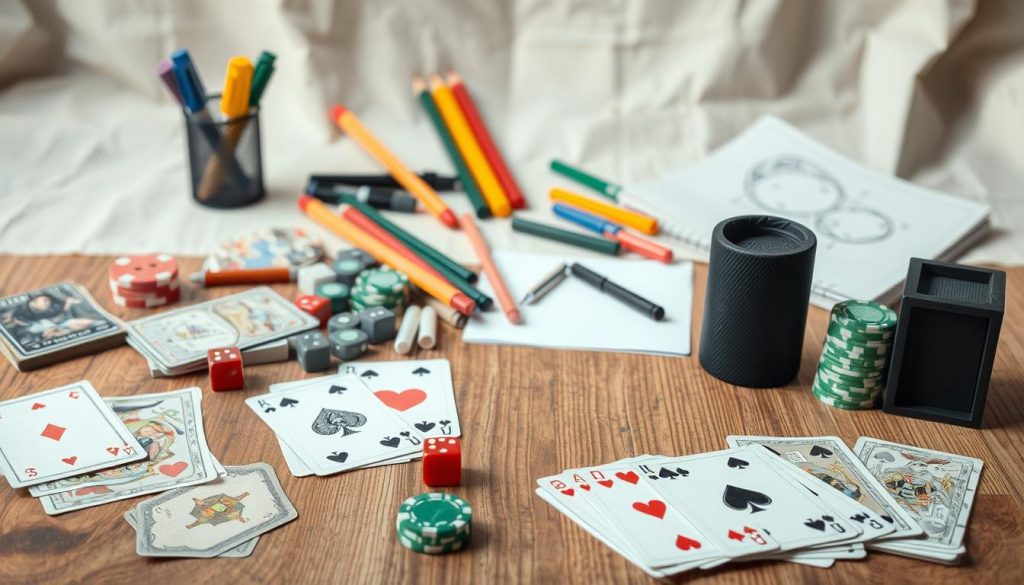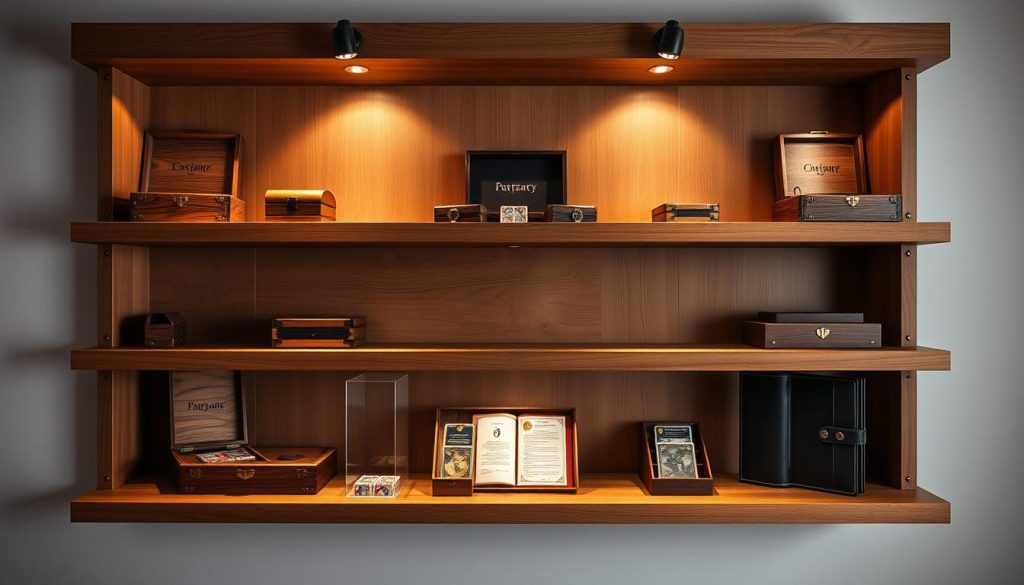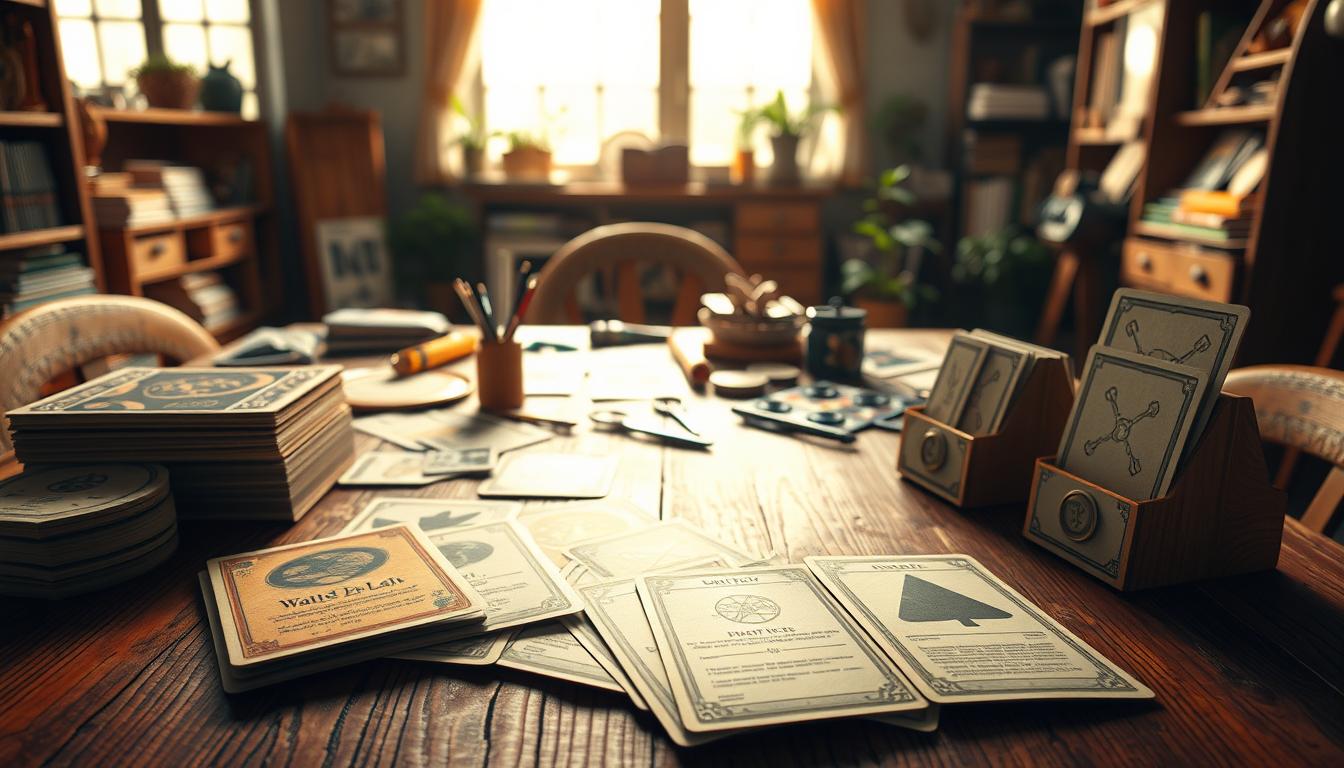Ever dreamed of making your own custom card games? DIY card game templates are a great way to make game nights special. You can create games that show off your creativity and bring joy to your friends and family.
Creating custom card games is more than just fun. It’s a chance to show off your game design skills. Whether you love board games or just play for fun, DIY templates make it easy to bring your ideas to life. You’ll love making something unique that shows off your style and interests.
Homemade card games can be anything from fun party games to serious challenges. With a little creativity and some simple templates, you can make games that everyone will remember. These games will become special moments with the people you care about.
Are you ready to start making your own games? This guide will show you how to design, develop, and share your own card games. Let’s make your gaming dreams come true!
Why Custom Card Games Are Taking Over Game Night
Tabletop gaming is changing fast with custom card games. Players want more than just what’s on the shelves. They’re making their own games. This way, they connect with friends and others who love games.
Building Community Through Personalized Gaming
DIY gaming has changed how we play and socialize. Custom card games bring people together. They spark creativity and make socializing fun.
Players find that making their own games strengthens bonds. It makes experiences more memorable.
- Encourages collaborative game design
- Promotes creative problem-solving
- Builds stronger social bonds
The Rise of DIY Gaming Culture
Design tools and online resources have made game creation easy. Now, anyone can make games that show off their interests. The choices are endless, from party games to educational sets.
Cost Benefits of Making Your Own Games
Making custom card games is not only fun but also saves money. It’s cheaper than buying commercial games. With a little creativity and some basic materials, you can make games that last for hours.
- Lower cost per game
- Unlimited design possibilities
- Personalized entertainment
Essential Materials and Tools for Card Game Creation
Making your own card game begins with the right stuff. You need the right materials and tools, whether you’re new or experienced. The right supplies make creating your game fun and easy.

Now, let’s look at the basic tools for your card game. Start with these key materials:
- High-quality cardstock (minimum 80-110 lb weight)
- Precision cutting tools like craft knives and paper trimmers
- Corner rounder for professional-looking card edges
- Graphic design software or templates
- Color printer or professional printing service
You don’t have to spend a lot on DIY game tools. There are many cheap but good options. Canva offers free templates, and local print shops can make your cards look great.
Think about getting some special supplies to make your game stand out. A laminating machine keeps your cards safe for many plays. Card sleeves and boxes also help keep your game in top shape.
- Digital design software
- Laminating machine
- Card protective sleeves
- Storage boxes
Great card game design is all about being creative and paying attention to details. With the right stuff, you can turn your ideas into real games.
DIY Card Game Templates for Beginners
Starting a card game can seem hard, but with the right templates, it’s easy. Anyone can become a game creator. First, learn about card layout design to make unique games.
Making your first game template needs careful planning and creativity. Start simple and add more details as you get better.
Basic Template Styles and Formats
There are many card game template styles for different games. Here are some popular ones:
- Character Cards: Great for role-playing and strategy games
- Action Cards: Perfect for interactive gameplay
- Resource Cards: Ideal for economic and management games
- Event Cards: Good for adding surprises
Designing Your First Card Layout
When designing your first card layout, focus on being clear and attractive. Think about these key points:
- Clear title area
- Readable text font
- Balanced visual hierarchy
- Consistent color scheme
Template Customization Tips
Customizing templates lets you make your game unique. First, know your game’s core and theme. Try different visuals but keep it easy to read and consistent.
The best templates show your creativity and support good gameplay. Keep practicing, trying new things, and don’t be scared to change traditional designs.
Digital Tools and Software for Card Design
Creating stunning card games is now easier than ever. Designers and game fans can turn their ideas into top-notch card games. They use card game software and online design tools for this.
Choosing the right digital design platform is key. It can greatly impact your card game making. Here are some top picks for digital card design:
- Adobe Photoshop: Professional-grade software for intricate card layouts
- Canva: User-friendly online design tools perfect for beginners
- GIMP: Free open-source alternative for budget-conscious designers
- Tabletop Simulator: Specialized card game software for digital prototyping
Modern online design tools have amazing features. They make card making easy. These platforms have templates, drag-and-drop tools, and ways to work together.
When picking card game software, think about your skill, budget, and design needs. Many tools offer free trials. This lets you try them out and find the best one for your project.
- Check compatibility with your computer system
- Look for intuitive user interfaces
- Evaluate export and printing capabilities
- Consider community support and tutorials
Whether you’re a pro game designer or just for fun, these digital tools are great. They help you create your card game ideas with precision and creativity.
Creative Theme Ideas for Custom Card Games
Creating custom card games is a fun and creative journey. You can make educational games, host parties, or test your strategy skills. The right theme can make your game unforgettable.
Creating unique card game themes lets players enter new worlds of fun and learning. Let’s explore some ideas for making card games that players will remember.
Educational Game Concepts
Educational card games make learning fun. They turn hard subjects into exciting adventures. This makes learning fun and interactive.
- Science Trivia Challenge: Create card games that explore biology, chemistry, or astronomy
- Historical Timeline Games: Design cards that help players understand chronological events
- Math Skill Building: Develop strategy card games that make numerical concepts accessible
Party Game Inspirations
Party card games bring people together, creating laughter and memories. They should be fun and encourage people to interact and be spontaneous.
- Themed Conversation Starters: Cards that prompt hilarious discussions
- Quick-Reaction Challenge Games: Fast-paced card games testing player reflexes
- Collaborative Storytelling: Games where players build narratives together
Strategy Game Templates
Strategy card games test your thinking and tactics. They need planning, resource management, and smart decisions.
- Resource Allocation Games: Design cards representing different strategic elements
- Territory Conquest Themes: Create game mechanics around territorial expansion
- Economic Simulation Cards: Develop games mimicking complex economic systems
Trying out these themes opens up a world of creativity. The best games show the creator’s passion and imagination.
Printing and Production Best Practices

Turning your card game design into a real product needs careful attention. DIY game making is not just about ideas. It’s about making those ideas real with quality printing.
Before you print your card game, think about a few important things:
- Paper quality and weight
- Printer settings and color calibration
- Cutting and finishing techniques
- Card protection and durability
Home printing is great for those on a budget. Standard home printers can do well with the right steps. Use thick cardstock (around 110-lb weight) for sturdy cards. Make sure your printer is set to the highest quality and colors match well.
For better quality, try professional printing services. Sites like The Game Crafter or local shops are experts in card games. They use top-notch card stocks, cut cards well, and add special finishes.
Here are some tips for great card game printing:
- Use high-resolution image files (300 DPI minimum)
- Test print several prototype versions
- Consider lamination for increased card durability
- Verify color accuracy across different prints
Whether you’re just starting or serious about DIY game making, knowing printing techniques is key. It helps you make a game that looks professional and is fun to play.
Game Mechanics and Rule Development
Making a great card game needs a deep understanding of mechanics and careful rule making. It’s all about making the game fun, fair, and engaging for players.
Creating exciting game mechanics is all about smart thinking and creativity. Game designers must write rules that make the game thrilling yet fair.
Balancing Game Elements
Game balancing is key for fun play. Here are some tips:
- Look at how players interact and the power balance
- Make sure all cards are fairly strong and have good abilities
- Make sure no one strategy can win all the time
- Test many scenarios to find any unfairness
Playtesting Strategies
Playtesting is vital for improving your card game. Get players from all levels to give honest feedback.
- Find players with different skills
- Write down what players say and what they find hard
- Watch how players follow the rules
- Take notes on what they suggest to make it better
Fine-tuning Game Rules
Designing a game is a process that needs patience and hard work. Listen to what players say, look at how they play, and be ready to change your game.
Creating a top card game is all about careful improvement and making sure players have a good time.
Card Game Storage and Protection Solutions

Making a custom card game is a fun and creative process. But, it’s important to protect your work so it lasts. Card game storage is not just about keeping cards safe. It’s also about keeping the memories and fun of game nights alive.
DIY game boxes are a great way to keep your custom cards safe. To make the perfect storage, you need to think about a few things:
- Choose durable materials like sturdy cardboard or wooden boxes
- Consider card size and game component dimensions
- Create compartments for different game elements
- Use protective sleeves for individual cards
Protecting your custom cards needs careful planning. Use high-quality card sleeves to keep them safe from moisture, dirt, and wear. Clear plastic sleeves are best for keeping card artwork safe and preventing damage during games.
When making your card game storage, think about how easy it should be to use. Use boxes with removable sections for easy setup and packing. Make sure to label compartments well so everything stays in its place.
For game designers and fans, a good storage system is more than just protection. It’s a part of the game’s design and experience. Try out different materials and designs to make a storage solution that fits your game’s theme and style.
Marketing and Sharing Your Custom Card Games
Sharing custom games is now super easy thanks to the internet. Online game design communities are great places for creators to show off their card game designs. Sites like BoardGameGeek, Reddit’s game design forums, and design groups are perfect for reaching out to fans and other designers.
Platforms like Kickstarter and Gamecrafter have changed the game for indie creators. They let designers test interest, get funding, and make pro-looking game decks without spending a lot upfront. This way, creators can meet players who love new game ideas.
When you share your game, make sure to protect your ideas. Learn about copyright basics. Use watermarks, document your work, and register your game mechanics. Joining game design groups, attending meetups, and online workshops can help improve your game. It also helps you meet people who like new gaming ideas.
Social media like Instagram, YouTube, and TikTok are great for showing off your game. Short videos, design process clips, and live demos can grab people’s attention. They can make others excited about your card game.

